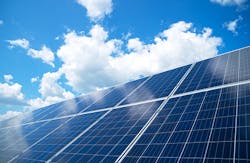With extreme weather events growing in frequency and magnitude, the electrical grid’s resiliency is in the spotlight. Scrutiny is broadening to include its expanding and potentially more vulnerable renewable components.
There’s good news: Photovoltaic (PV) solar garnered good press in September’s devastating Hurricane Ian – a large solar-powered residential community stayed online while surrounding areas were blacked out. But solar farms have taken it on the chin in others, notably in two powerful storms that hit Puerto Rico in 2017 that led the National Renewable Energy Laboratory (NREL) to initiate research into how solar PV systems can be hardened.
Promising cleaner power, solar and wind are contributing steadily more to the electrical grid. But the other side of the coin is reliability. How will renewables assets stand up to natural disasters, such as hurricanes, floods, fires, and earthquakes? How does its risk profile stack up to that of fossil fuel-generating infrastructure?
Those are questions gnawing at the Federal Emergency Management Administration (FEMA), whose Applied Technology Council’s Seismic Code Support Committee has proposed tougher construction standards on ground-mounted utility-scale solar, wind, and storage projects. The FEMA advisory panel is asking the International Codes Council (ICC) to move those installations into a higher structural risk category in the pending 2024 International Building Code it administers, a move it says would better ensure uninterrupted performance in the path of severe storms or seismic events.
Renewable energy interests, however, are pushing back. Three groups, American Clean Power Association, Distributed Wind Energy Association, and Solar Energy Industries Association are protesting the proposal, saying a tougher standard would raise the cost of installing solar arrays and wind turbines, dampen their performance, and put renewable energy investment at risk at a critical phase in its development.
In a letter sent to the ICC and endorsed by more than 300 companies, the groups take issue with the premise that renewable power assets need to be hardened against extreme weather events and that the cost of reducing any marginal added risk would be too high.
“A code change proposal under consideration for the future 2024 IBC would significantly affect the deployment of PV and wind facilities by unnecessarily driving up construction costs without achieving its intended benefit of grid resiliency and reliability,” the letter states. “Grid reliability and grid recoverability are not based on the survivability of structures, but on grid planning and redundancy.”
The code change under consideration would move covered solar and wind projects from close to the lowest to the highest level of structural integrity. That would mean more materials and changes in design and construction, which would impact deliverability and performance, opponents say, needlessly cutting into the value proposition for renewable energy. Projects could be delayed or canceled because of higher costs or lack of availability of products meeting the standard. And completed projects may be less efficient; wind turbine height, for instance, might have to be reduced, reducing power production.
Renewable energy interests pleading that case are urging a compromise solution that includes capping the risk categorization for solar facilities at Level 2, only one notch up from current requirements. At that level, they say, deployment of renewable energy projects will be able to stay on course for needed growth.
ICC members considering the 2024 IBC have had the original FEMA-led proposal and the alternatives in hand since mid-October. Voting is scheduled to end November 1. Once votes are tallied, renewable energy interests will have a clearer picture of whether 2023 will be a year of transition to a set of stricter requirements.
Tom Zind is a freelance writer based out of Lees Summit, Mo. He can be reached at [email protected].
About the Author
Tom Zind
Freelance Writer
Zind is a freelance writer based in Lee’s Summit, Mo. He can be reached at [email protected].
